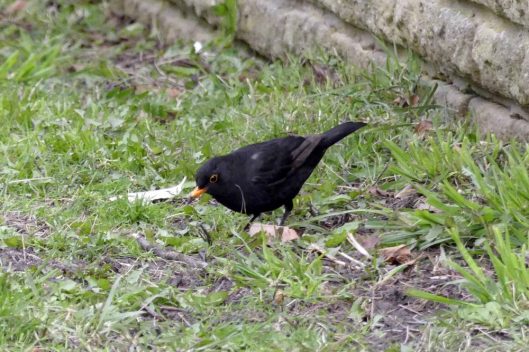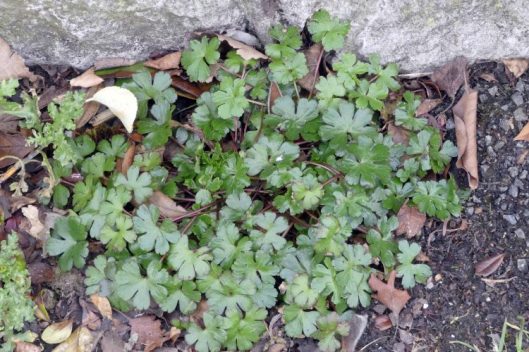Tags
common cornsalad, common fumitory, common mouse-ear, common whitlow grass, Danish scurvygrass, garden escapes, plants on pavements, rhos-on-sea
This is one of the best times of year to look for street flowers here in Rhos on Sea. Seeds will have had the chance to germinate and those plants with speedy life-cycles should be able to complete them before Easter, whose imminent arrival usually prompts the big clean-up of streets and other public spaces in time for the holiday, to welcome and impress an influx of visitors. With that in mind, on a sunny but cool day, I walked the route from my home to the sea-front, taking the roads and streets I’ve always found best for flowers and if I’m lucky, other wildlife too. My walk begins on Tan y Bryn Road, which at this end has something of a country lane feel to it. On one side, mature trees and gardens half-hide several big Victorian houses, now converted to Residential Homes, that are backed by the woodland of Bryn Euryn. On the other side, there’s a variety of houses of differing sizes and ages, with gardens also of varying sizes and maturity. In front of one, a strip of mown grass was providing happy hunting for a blackbird.
In the shade at the base of a fence an Italian lords-and-ladies brings a touch of the exotic to the roadside. This is plant is included in most wildflower books, where it may also be named as rare lords-and-ladies, described as Nationally Scarce and listed as near-threatened. This is because in the wild in Great Britain it is only found very locally near the south coast, elsewhere it is much more widespread as a garden escape, as it is here.
Close by, on an otherwise dull street corner behind a wooden bench, is a patch of three-cornered garlic, or as I know it, three-cornered leek. This is another plant with its origins in the Mediterranean region, but introduced here close to 300 years it is now perfectly at home here. Both common names refer to the stems, which are triangular in shape. Another common name is white bluebell, and it’s east to see why. If you look more closely you’ll see the flowers are similarly bell-shaped and pretty, but unlike a true white bluebell, each petal has a fine green line on the outside. The whole plant smells quite strongly garlicky and is edible. This patch, has been thriving for several years and unless it’s ‘tidied up’, it will continue to flower for months to come.


A house sparrow sitting chirping on top a hedge took me by surprise; this is the first one I’ve seen this far up and away from the main part of the village, so I hope that’s a sign that their numbers are increasing here and are moving out to find and establish new territories.
Limestone walls, built from locally-quarried stone form the boundaries of gardens and grounds along many of the roads and streets of the village. Cracks in them give refuge to a variety of wandering plants, and their bases trap leaves and accumulate layers of dust and dirt blown by the wind and washed in from roads and pavements. In their shelter, you never know what seeds might have been deposited and found the perfect haven, or become trapped there while seeking a more hospitable home. Many will start to grow but won’t come to much, succumbing early to drought, being sprayed with chemicals to kill them off to ‘tidy up’ the streets, or just from having landed in the wrong place at the wrong time. Those that survive and thrive are most likely to be annual plants with a speedy life cycle; bittercress, common chicory, groundsel, dandelions and sow-thistles always do well.
One of our prettiest wildflowers both in flower and in leaf is common fumitory. This flowering patch currently adorns the base of a wall opposite the entrance to Bryn Euryn Nature Reserve.
Here I crossed over into Rhos Road, one side of which is one of the best roads I know for spotting opportunistic plants, both wildflowers and garden ones bent on making an escape. This little group has common cornsalad, groundsel, herb robert, St John’s wort and other seedlings as yet too small to see properly.
Further along aubretia, or rock cress, a popular garden rockery plant rubs leaves with hairy bittercress and yet more groundsel.
On the corner of a driveway, purple-leaf shamrock, dandelion, purple toadflax, sow thistle, bittercress and more groundsel vie for space.
Perhaps the most surprising plant of the day was this Danish scurvygrass. It is a sea-side plant, so it’s in the right location, but I’ve not found it growing around the village beach or seafront, so I’d love to know how it got here.
Although sunny, it was quite a cool day, so I was surprised to spot this little bee moving around amongst the leaves of a dandelion. I don’t know what species it is, but I think most likely a mining bee.


The opposite side of the road is shaded and in part lined with lime trees. I imagine that once these lovely trees formed an unbroken line, but now just 17 of them remain, with gaps of varying lengths between them. It’s such a shame the empty spaces have never been filled. The trees are broad-leaved limes, which now have new red twigs with leaf buds that are characteristically shaped like a boxing glove. Aphids love these trees and are already to be found on twigs, just waiting for the leaf buds to open.
Nearing the village centre the busier main streets are not as hospitable to stray plants and I hurried on to the next spot I know that offers sanctuary, appropriately the base of the wall around the church. Here I found common mouse-ear, a bit straggly and not quite fully flowering yet, but there just the same.
Around the corner, as I’d hoped, I had more joy. I’ve found a few little treasures here in the past and today there were a few more There was more bittercress and common mouse-ear, both growing through a lovely patch of common whitlow grass which had reached a size and height that I could get a reasonable photograph of.


Next to that, a touch more groundsel and the leaves of a shining cranesbill made a pretty picture to finish with; I hope it survives long enough to flower.












I love this time of year when the world turns green again and the plants burst into flower!
LikeLike
Me too Finn, when everything feels so fresh, enthusiastic and hopeful!
LikeLike